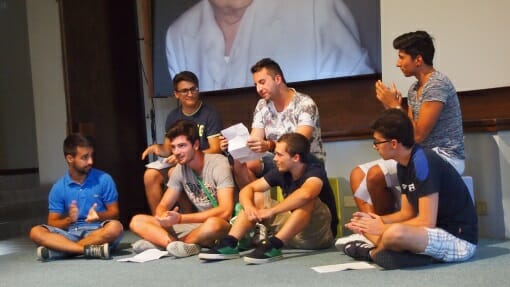
Aug 18, 2015 | Focolare Worldwide
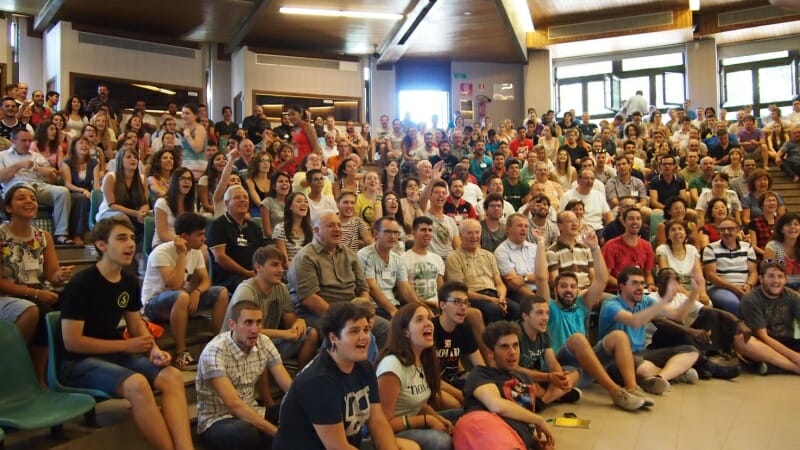 The somewhat quirky diversity of the hall at the Chiara Lubich Centre in Trent this year was a bit surprising: 250 young people between the ages of 16 and 30 from more than 20 countries; 70 priests and seminarians and some twenty adults who are all committed in living the spirituality of the Focolare at the parish or diocesan levels. What was the idea behind this meeting which was planned for the 2cnd to the 8th of August? What is the connection between the different cultural backgrounds? The first answer can be found in the title of the meeting: “Like yesterday,” and the second answer in the city of Trent itself. All of these young people and adults were gathered to reflect on the first generative seed of their own spiritual charism and to look back even physcially at the journey that has inspired the Focolare Movement from its beginnings. “The meeting opened in an atmosphere of explosive joy,’ Ludovico and Elonora recount. “The programme is meant to be an immersion in the life of those early days and the radicalness in living the Word.” The programme alternated between thematic topics and excursions to the places where the Focolare began: Piazza Cappuccini, Fiera di Primiero, Tonadico, Goccia d’Oro. “During the Mass in the Cappuchin church,” Zbyszek writes, “we declared ourselves ready with the help of Christ’s grace, to give our lives one for the other beginning from the small things of everyday life. In the place where God had sealed the pact of unity between Chiara and Igino Giordani (Foco), we also wishe to renew that mutual love which we wish to live as they did that yesterday.”
The somewhat quirky diversity of the hall at the Chiara Lubich Centre in Trent this year was a bit surprising: 250 young people between the ages of 16 and 30 from more than 20 countries; 70 priests and seminarians and some twenty adults who are all committed in living the spirituality of the Focolare at the parish or diocesan levels. What was the idea behind this meeting which was planned for the 2cnd to the 8th of August? What is the connection between the different cultural backgrounds? The first answer can be found in the title of the meeting: “Like yesterday,” and the second answer in the city of Trent itself. All of these young people and adults were gathered to reflect on the first generative seed of their own spiritual charism and to look back even physcially at the journey that has inspired the Focolare Movement from its beginnings. “The meeting opened in an atmosphere of explosive joy,’ Ludovico and Elonora recount. “The programme is meant to be an immersion in the life of those early days and the radicalness in living the Word.” The programme alternated between thematic topics and excursions to the places where the Focolare began: Piazza Cappuccini, Fiera di Primiero, Tonadico, Goccia d’Oro. “During the Mass in the Cappuchin church,” Zbyszek writes, “we declared ourselves ready with the help of Christ’s grace, to give our lives one for the other beginning from the small things of everyday life. In the place where God had sealed the pact of unity between Chiara and Igino Giordani (Foco), we also wishe to renew that mutual love which we wish to live as they did that yesterday.” 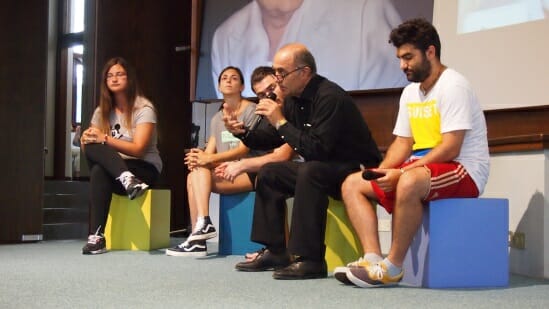 Then we had an opportunity to be enriched by presentations from experts in the fields of communication, interreligious dialogue and cooperation and development in the Action for a United World (AMU). Thanks to them we were able to reflect on communication and the challenges of our multiethnic and multi-religious society. Much time was dedicated to delving into the topics of immigration and welcoming thanks to the precious collaboration by the Cinformi Project, which presented the model of welcoming that has been proposed and applied by the city of Trent, placing itself at our service with active workshops involving two visits to refugee camps. Some of the most unforgettable moments of the meeting were spent with a hundred refugees who are waiting to see what the future will bring.
Then we had an opportunity to be enriched by presentations from experts in the fields of communication, interreligious dialogue and cooperation and development in the Action for a United World (AMU). Thanks to them we were able to reflect on communication and the challenges of our multiethnic and multi-religious society. Much time was dedicated to delving into the topics of immigration and welcoming thanks to the precious collaboration by the Cinformi Project, which presented the model of welcoming that has been proposed and applied by the city of Trent, placing itself at our service with active workshops involving two visits to refugee camps. Some of the most unforgettable moments of the meeting were spent with a hundred refugees who are waiting to see what the future will bring.  Several of them came to see us at the meeting. Rita confided: “I was so struck by Lamin, a young Muslim from Ghana who had written a poem to his mother and wished to read it to everyone. It was a poem filled with nostalgia but also hope. The eyes of these people says it all and they can never forget.” At the conclusion of the meeting two goals were set – one short-term and the other long-term: the World Youth Day meeting (WYD) in Poland; and the unity of the world in accordance with Jesus’s prayer that all be one for which we wish to spend our lives. “We leave committed to becoming the ‘living Word,” Danilo and Emmanuele write and to take this “pure water from the source” into our own lands and into our daily life in our peripheries, offering it to every neighbour that goes by.”
Several of them came to see us at the meeting. Rita confided: “I was so struck by Lamin, a young Muslim from Ghana who had written a poem to his mother and wished to read it to everyone. It was a poem filled with nostalgia but also hope. The eyes of these people says it all and they can never forget.” At the conclusion of the meeting two goals were set – one short-term and the other long-term: the World Youth Day meeting (WYD) in Poland; and the unity of the world in accordance with Jesus’s prayer that all be one for which we wish to spend our lives. “We leave committed to becoming the ‘living Word,” Danilo and Emmanuele write and to take this “pure water from the source” into our own lands and into our daily life in our peripheries, offering it to every neighbour that goes by.”
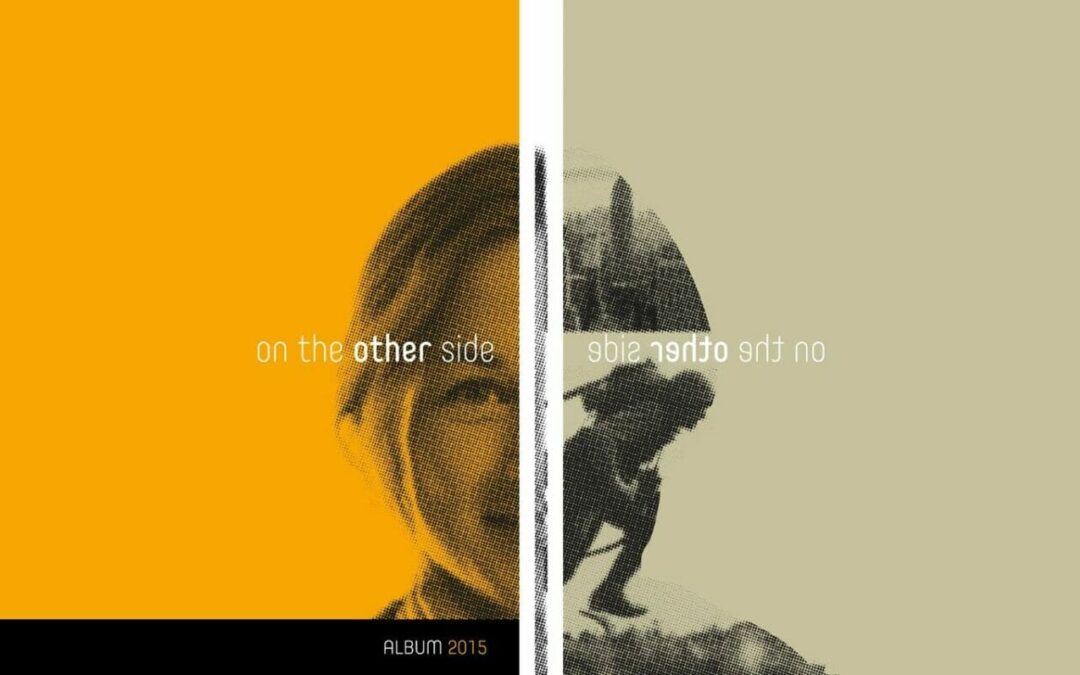
Aug 17, 2015 | Non categorizzato
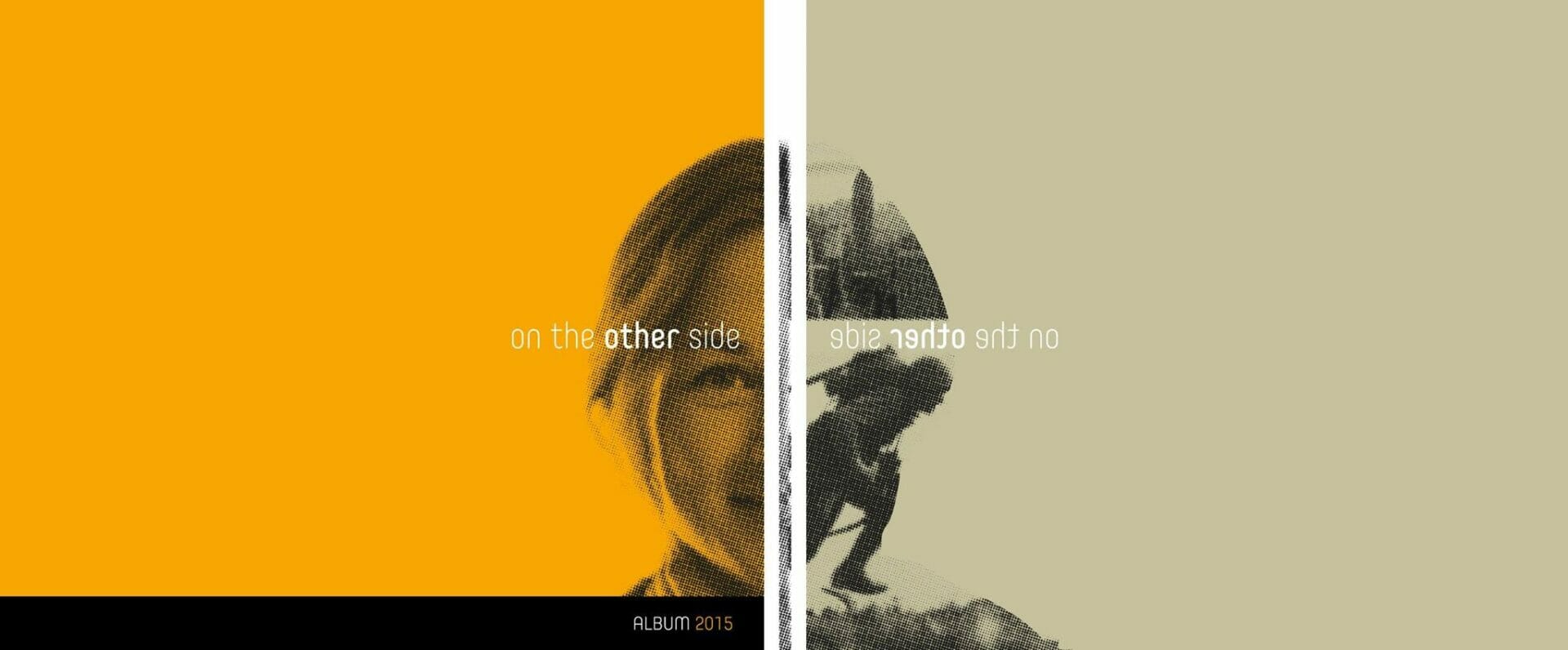 Eleven songs in five languages: English, Italian, Spanish, Portuguese and Korean. 47 minutes of pop-rock and world music, full of passion, force, vitality in music and words branded Gen Verde. According to the band’s manager, Sally McAllister, “This album is autobiographical and biographical at the same time.” It is an affirmation shared by all the members of the group. In fact, as they say, “It is biographical because the undisputed protagonist of this album is humanity that recounts its story: of people in the face of present-day challenges, the tragedies and conquests, history which marks the world’s pace, people moving along the roads of the planet in search of a land, dignity, and a place they can call their home.” But it is also autobiographical, since it is “imbued with our own stories and the musical cultures we come from.” “We wanted to try our hand,” the Gen Verde members say, “in recounting the moments and facts that marked a turning point in our lives. Different paths, with various departure points from physical sites and soul places that oftentimes are diametrically opposed but which all target that sole horizon of fraternity.” In fact, “Every piece tells a story, such as Voz de la verdad, a homage to Oscar Romero,” says the Salvadorean, Xochitl Rodríguez. And also Chi piange per te? – the cry of thousands of migrants on the banks of the Mediterranean, which continues to echo across Africa to Europe, and in every continent where people are forced to leave in order to survive. Another song You’re Part of Me is the interrupted story of the Korean people, who refuse to give in to the scandal of separation. The musical arrangement is K-pop, a genre that is very popular today with the young Koreans, and says the desire for unity is not an issue of 70 years ago, but is one of today, of this generation that will not give up.”
Eleven songs in five languages: English, Italian, Spanish, Portuguese and Korean. 47 minutes of pop-rock and world music, full of passion, force, vitality in music and words branded Gen Verde. According to the band’s manager, Sally McAllister, “This album is autobiographical and biographical at the same time.” It is an affirmation shared by all the members of the group. In fact, as they say, “It is biographical because the undisputed protagonist of this album is humanity that recounts its story: of people in the face of present-day challenges, the tragedies and conquests, history which marks the world’s pace, people moving along the roads of the planet in search of a land, dignity, and a place they can call their home.” But it is also autobiographical, since it is “imbued with our own stories and the musical cultures we come from.” “We wanted to try our hand,” the Gen Verde members say, “in recounting the moments and facts that marked a turning point in our lives. Different paths, with various departure points from physical sites and soul places that oftentimes are diametrically opposed but which all target that sole horizon of fraternity.” In fact, “Every piece tells a story, such as Voz de la verdad, a homage to Oscar Romero,” says the Salvadorean, Xochitl Rodríguez. And also Chi piange per te? – the cry of thousands of migrants on the banks of the Mediterranean, which continues to echo across Africa to Europe, and in every continent where people are forced to leave in order to survive. Another song You’re Part of Me is the interrupted story of the Korean people, who refuse to give in to the scandal of separation. The musical arrangement is K-pop, a genre that is very popular today with the young Koreans, and says the desire for unity is not an issue of 70 years ago, but is one of today, of this generation that will not give up.”
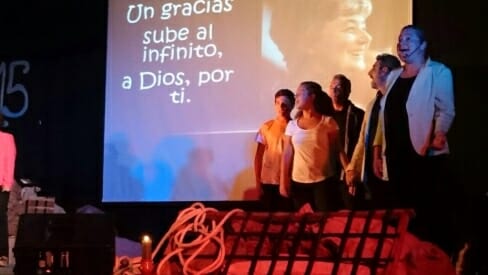
Aug 16, 2015 | Focolare Worldwide, Senza categoria
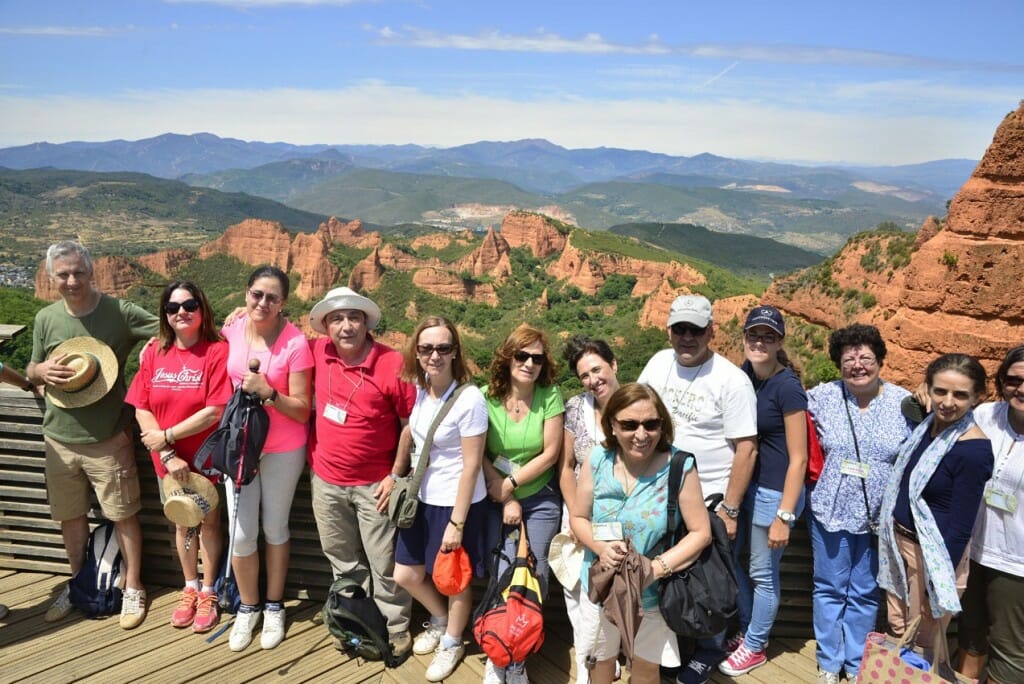 One person attending the Mariapolis in Astorga for the first time described it as a “heart to heart meeting.” It was just one of the many similar Mariapolises that are underway or have already taken place across Europe and in many other lands. The Mariapolis of August 2-6 was a peaceful “invasion” of the town by 800 people from several parts of Spain, but also from France, Italy, Germany and Brazil. During excursions to monuments and museums, at Mass celebrated in the Gothic Cathedral, or during the evening concerts with all types of music – the streets were crowded with people from the Mariapolis. And the local citizens of Astorga whose curiosity had been aroused by the fraternal spirit of those people, responded in kind. One woman stopped a girl who was walking down the street to thank her for the presence of such a joyful group in their city. The balance between periods of relaxation, formation, dialogue, listening to testimonies and play was much appreciated. It was a good mix that contributed to the objectives of the Mariapolis: to favour an encounter with oneself, God, and others. One participant observed: “It wasn’t a crescendo that began at a one level and then progressed in quality or intensity. Each day was full, complete, and totally valuable in itself.” Amongst the activities for children and teens were several marches in the city, with stops in certain streets and squares where activities were held. The Astorga Mariapolis was also on Facebook, a virtual meeting spot for both the participants and for those who could not physically attend. Many contributed photos that can still be accessed online. Some of the comments: https://www.facebook.com/mariapolisastorga2015 “This is my first Mariapolis,” Cati writes. “These days were filled with brotherhood, love and unity. My family and I thank everyone who made this wonderful event possible;” “I’m still on my way home towards Toledo,” writes Paco. “I take the opportunity to thank everyone for these past few days. I have to say that it was a Mariapolis filled with graces.”
One person attending the Mariapolis in Astorga for the first time described it as a “heart to heart meeting.” It was just one of the many similar Mariapolises that are underway or have already taken place across Europe and in many other lands. The Mariapolis of August 2-6 was a peaceful “invasion” of the town by 800 people from several parts of Spain, but also from France, Italy, Germany and Brazil. During excursions to monuments and museums, at Mass celebrated in the Gothic Cathedral, or during the evening concerts with all types of music – the streets were crowded with people from the Mariapolis. And the local citizens of Astorga whose curiosity had been aroused by the fraternal spirit of those people, responded in kind. One woman stopped a girl who was walking down the street to thank her for the presence of such a joyful group in their city. The balance between periods of relaxation, formation, dialogue, listening to testimonies and play was much appreciated. It was a good mix that contributed to the objectives of the Mariapolis: to favour an encounter with oneself, God, and others. One participant observed: “It wasn’t a crescendo that began at a one level and then progressed in quality or intensity. Each day was full, complete, and totally valuable in itself.” Amongst the activities for children and teens were several marches in the city, with stops in certain streets and squares where activities were held. The Astorga Mariapolis was also on Facebook, a virtual meeting spot for both the participants and for those who could not physically attend. Many contributed photos that can still be accessed online. Some of the comments: https://www.facebook.com/mariapolisastorga2015 “This is my first Mariapolis,” Cati writes. “These days were filled with brotherhood, love and unity. My family and I thank everyone who made this wonderful event possible;” “I’m still on my way home towards Toledo,” writes Paco. “I take the opportunity to thank everyone for these past few days. I have to say that it was a Mariapolis filled with graces.”  A project was proposed that would bring the Mariapolis spirit into daily life: “We’re all Mediterranean” to help inform European citizens on the drama of immigration that is taking place in our common Mediterranean Sea, from southern borders, from disadvantaged and war-torn lands, in search for better living conditions. This project, which is in harmony with the theme of this year’s Mariapolis (“Paths that meet”) involves a collection of signatures to petition the European Union for a significant change in migration policy. On the last day of the Mariapolis when the participants were asked for their evaluation of the event, everyone said they were satisfied, especially with regard to the way they felt welcomed from the moment they arrived, even those who were attending for the first time. The town of Astorga built to a human scale and with such a pleasant climate, combined so many features that helped facilitate the coming together which was the goal of the Mariapolis. For this reason the organisers of the Mariapolis write: “the Focolare Movement expresses its warm gratitude to the Diocese and Town Administration for their exquisite collaboration.”
A project was proposed that would bring the Mariapolis spirit into daily life: “We’re all Mediterranean” to help inform European citizens on the drama of immigration that is taking place in our common Mediterranean Sea, from southern borders, from disadvantaged and war-torn lands, in search for better living conditions. This project, which is in harmony with the theme of this year’s Mariapolis (“Paths that meet”) involves a collection of signatures to petition the European Union for a significant change in migration policy. On the last day of the Mariapolis when the participants were asked for their evaluation of the event, everyone said they were satisfied, especially with regard to the way they felt welcomed from the moment they arrived, even those who were attending for the first time. The town of Astorga built to a human scale and with such a pleasant climate, combined so many features that helped facilitate the coming together which was the goal of the Mariapolis. For this reason the organisers of the Mariapolis write: “the Focolare Movement expresses its warm gratitude to the Diocese and Town Administration for their exquisite collaboration.”
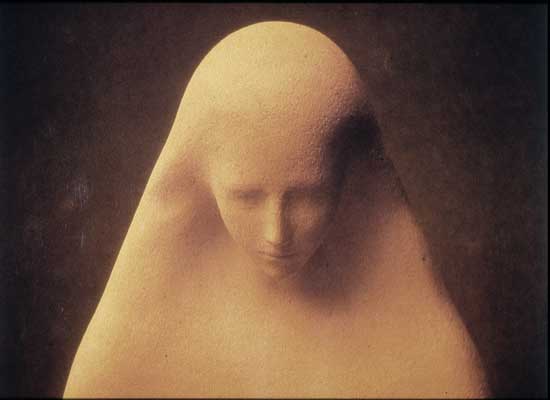
Aug 15, 2015 | Non categorizzato

Ave Cerquetti, ‘Mater Christi’ – Roma, 1971
Aug 14, 2015 | Non categorizzato
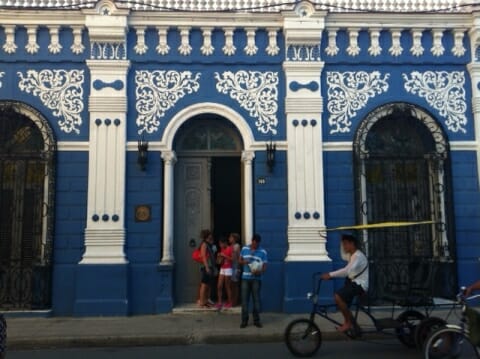
Aug 13, 2015 | Focolare Worldwide
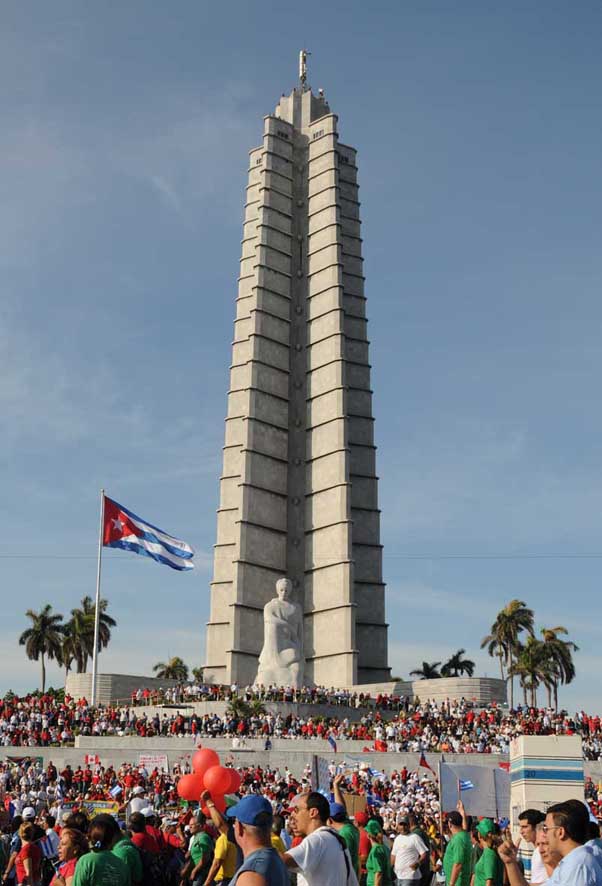
Revolution Square and José Martí Memorial
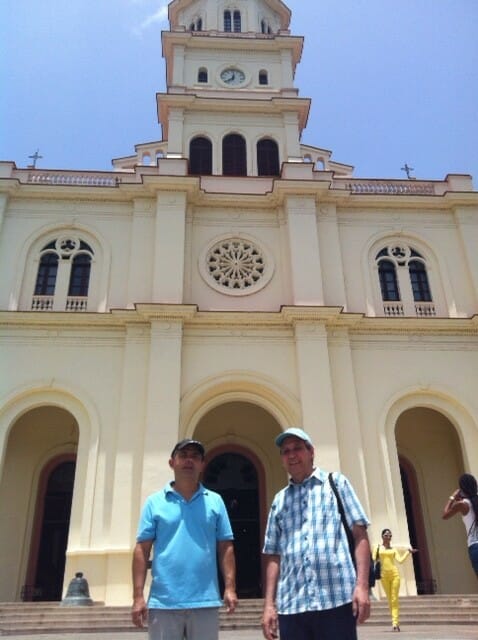
the National Shrine of the Virgin of Charity of Cobre
 The Focolare Movement’s contribution. The Focolare communities across the island are trying – together with the Church – to offer its own contribution, geared mainly towards formation in fraternity in opposition to the “throw-away culture”, to privileging those in most need, promoting unity in diversity and proposing dialogue as an indispensable method for peaceful coexistence in a multicultural society. Conclusion. The message of the Cuban Catholic Bishops concludes with a prayer to the Virgin of Charity, Mother of Cuba, the One whom we invoke as Mother and Queen of Mercy, that she might take maternal care of this longed-for visit. She who has accompanied our people in good times and in bad, may she obtain a great blessing from Heaven for Cuba and her children wherever they may be, whatever they may think or believe.” From an interview with correspondent Gustavo Clariá _____________________ [1] Castellano Dennys, Sergio L. and Monterrey, Fontanella. Sin pecado concebidas, La Caridad del Cobre en las artes visuales cubanas, (Havana: Editorial UH, 2014), p. 66. (Our translation.)
The Focolare Movement’s contribution. The Focolare communities across the island are trying – together with the Church – to offer its own contribution, geared mainly towards formation in fraternity in opposition to the “throw-away culture”, to privileging those in most need, promoting unity in diversity and proposing dialogue as an indispensable method for peaceful coexistence in a multicultural society. Conclusion. The message of the Cuban Catholic Bishops concludes with a prayer to the Virgin of Charity, Mother of Cuba, the One whom we invoke as Mother and Queen of Mercy, that she might take maternal care of this longed-for visit. She who has accompanied our people in good times and in bad, may she obtain a great blessing from Heaven for Cuba and her children wherever they may be, whatever they may think or believe.” From an interview with correspondent Gustavo Clariá _____________________ [1] Castellano Dennys, Sergio L. and Monterrey, Fontanella. Sin pecado concebidas, La Caridad del Cobre en las artes visuales cubanas, (Havana: Editorial UH, 2014), p. 66. (Our translation.)
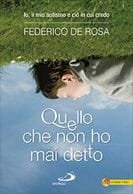
Aug 12, 2015 | Focolare Worldwide, Senza categoria
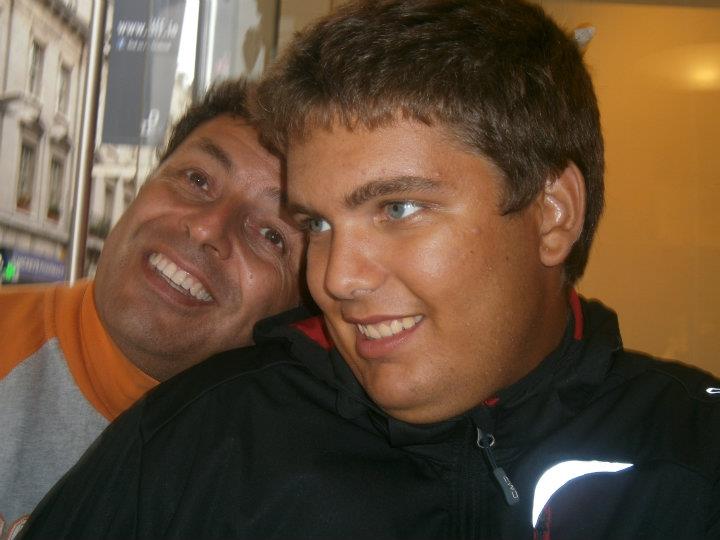
Federico with his Dad
 Now that he could write, his self-esteem grew, up to when he published a book Quello che non ho mai detto (“The words I have never said”) wherein, for the first time we can see the point of view of a boy who explains his syndrome with rare and precious observations. This is how he emerged from his isolation, and finally experienced the joy of sharing his emotions. He concluded his studies in science up to secondary school certificate stage. To this day, Federico says almost nothing. “I assure you,” he wrote, ” that I am almost unable to speak verbally. I express myself with single words, and only rarely with a small phrase. I can write only in big and shaky capital letters.” And thanks to the computer, for the first time he was able to play with a friend and attend, together with his classmates, the first year of secondary school, and years later, participate “actively” in the meetings of the confirmation group. “Little by little, ” he recounts, “my laptop became an inseparable companion. With my computer and the support of a qualified person at my side, I can express my views in every situation.” Today Federico studies percussion, has many friends, helps people with autism in their families with down to earth suggestions, and has a lot of plans for the future. “Now my life has found its course,” he wrote, “thanks to the operators who taught me how to use the system, and my parents who launched themselves in this adventure with enthusiasm. Today I am happy with my life, and a great part of the merit goes to them.” But he’s not thinking just of himself: “How many autistic people could have become other Federicos if diagnosed properly and given early intervention and been greatly loved and supported?”. His dream for the future? “I wish to travel the world to meet families with infants who have a communication disorder, to try and interact with these children and to treat autism accordingly. Whenever a child needs me, I’ll be there to help.” Source: Città Nuova online
Now that he could write, his self-esteem grew, up to when he published a book Quello che non ho mai detto (“The words I have never said”) wherein, for the first time we can see the point of view of a boy who explains his syndrome with rare and precious observations. This is how he emerged from his isolation, and finally experienced the joy of sharing his emotions. He concluded his studies in science up to secondary school certificate stage. To this day, Federico says almost nothing. “I assure you,” he wrote, ” that I am almost unable to speak verbally. I express myself with single words, and only rarely with a small phrase. I can write only in big and shaky capital letters.” And thanks to the computer, for the first time he was able to play with a friend and attend, together with his classmates, the first year of secondary school, and years later, participate “actively” in the meetings of the confirmation group. “Little by little, ” he recounts, “my laptop became an inseparable companion. With my computer and the support of a qualified person at my side, I can express my views in every situation.” Today Federico studies percussion, has many friends, helps people with autism in their families with down to earth suggestions, and has a lot of plans for the future. “Now my life has found its course,” he wrote, “thanks to the operators who taught me how to use the system, and my parents who launched themselves in this adventure with enthusiasm. Today I am happy with my life, and a great part of the merit goes to them.” But he’s not thinking just of himself: “How many autistic people could have become other Federicos if diagnosed properly and given early intervention and been greatly loved and supported?”. His dream for the future? “I wish to travel the world to meet families with infants who have a communication disorder, to try and interact with these children and to treat autism accordingly. Whenever a child needs me, I’ll be there to help.” Source: Città Nuova online
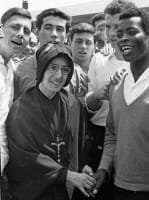
Aug 11, 2015 | Focolare Worldwide
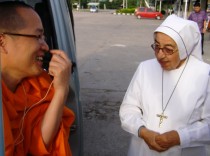 Several Buddhist monks that visited the focolare regularly also knew her well. Benedetta was a woman who let herself be approached and known, without fear and with gentleness. She knew how to welcome people and you could go to her any time. Any problem, great or small, any need, some good news to share: she wasn’t scandalised by anything, she knew people’s hearts and knew how to love them. One bishop once said of Sister Benedetta that she was “a Sister of silver and gold” because of all the money she was able to find for the poor. When visiting the extreme north of Thailand, you were always obliged to go and ‘have a chat’ with her, as she would say. She enjoyed hearing the news of her ‘great family’ as she loved to call the Movement, and she shared its life with many others. We would often meet people in the Mariapolis to whom she had spoken about the spirituality of unity, or else someone who had passed by the focolare to meet us because they had heard Sister Bene talk about us. In other words, Benedetta was a true spiritual mother who gave much supernatural life to so many people, and many of them attended her funeral along with a large crowd of bishops, priests and laity. The small church of Wien Pa Pao and the adjoining convent where she lived were filled to overflowing.
Several Buddhist monks that visited the focolare regularly also knew her well. Benedetta was a woman who let herself be approached and known, without fear and with gentleness. She knew how to welcome people and you could go to her any time. Any problem, great or small, any need, some good news to share: she wasn’t scandalised by anything, she knew people’s hearts and knew how to love them. One bishop once said of Sister Benedetta that she was “a Sister of silver and gold” because of all the money she was able to find for the poor. When visiting the extreme north of Thailand, you were always obliged to go and ‘have a chat’ with her, as she would say. She enjoyed hearing the news of her ‘great family’ as she loved to call the Movement, and she shared its life with many others. We would often meet people in the Mariapolis to whom she had spoken about the spirituality of unity, or else someone who had passed by the focolare to meet us because they had heard Sister Bene talk about us. In other words, Benedetta was a true spiritual mother who gave much supernatural life to so many people, and many of them attended her funeral along with a large crowd of bishops, priests and laity. The small church of Wien Pa Pao and the adjoining convent where she lived were filled to overflowing.  Sr Bene, of the Sisters of Charity of the Infant Mary, known to the secular world as Benedetta Carnovali, born in 1925, was a pillar of the Movement and many of the people who belong to the Focolare community of Thailand were personally drawn to the Movement by her (including Buddhists). ‘A real Sister and a true focolarina,’ as she was described by some: an ‘out-of-the-ordinary’ Sister, always on the go and, at the same time, ‘firm’ when personally loving the person next to her. She was a friend who would call you up to wish you a happy birthday, even though her voice became feebler every year, but not her interior strength. Whenever you approached her you were never given the impression that you had disturbed her: it was as if she had been expecting you alone and didn’t have anything else to do but welcome you. But she was quite busy, judging from all the adoptions at a distance which she personally saw to, up until the last days of her life. Sister Bene had met the Focolare’s spirituality of unity from an order priest in 1963, and from that moment spent her life that many in Myanmar – where she was living in that period and then in Thailand when all Religious were expelled by the regime – could know the spirituality and live it. When she was transferred to Thailand, she continued to deepen her friendship with the Focolare. When she went to spend a few days at the focolare, she nourished herself on the words of Chiara Lubich. Like all those who genuinely follow God, Sister Benedetta also encountered her nights, ‘the storm’ as she followed Jesus. She faced them as a true disciple of Jesus, with heroic charity. Deeply united with Vale Ronchetti, one of the first focolarine, she pressed on in the midst of much miscomprehension: ‘How can a nun belong to a movement with so many lay people in it?’ she was often asked; and there were other great and small persecutions that on a human level were completely absurd. Yet, in some mysterious way, God made use of these things to make Sister Benedetta more and more a Sister, more and more a spiritual daughter of Chiara (as Benedetta often said), and an apostle of unity who has no counterpart in the Asian southeast judging from the fruits she bore. She leaves a legacy of love, gentleness, sweetness and strength, loving service to the least: towards the people of the Akha tribe, for example. She leaves us withthat smile so typical of those who have experienced that it is possible to transform suffering in Love and make that Love their reason for living. Sister Benedetta ‘flew” to Heaven at the age of ninety, after listening to the Focolare song that she loved: ‘Solo grazie’. She died consumed but serene, just as she had always lived: in peace because she was certain that the ‘arms’ that had embraced her from her childhood (she was an orphan) and carried her through her life as a Religious, were there waiting for her now on this last stretch of her journey. She was a wonderful woman who shows that it is still possible to become a saint today. Luigi Butori
Sr Bene, of the Sisters of Charity of the Infant Mary, known to the secular world as Benedetta Carnovali, born in 1925, was a pillar of the Movement and many of the people who belong to the Focolare community of Thailand were personally drawn to the Movement by her (including Buddhists). ‘A real Sister and a true focolarina,’ as she was described by some: an ‘out-of-the-ordinary’ Sister, always on the go and, at the same time, ‘firm’ when personally loving the person next to her. She was a friend who would call you up to wish you a happy birthday, even though her voice became feebler every year, but not her interior strength. Whenever you approached her you were never given the impression that you had disturbed her: it was as if she had been expecting you alone and didn’t have anything else to do but welcome you. But she was quite busy, judging from all the adoptions at a distance which she personally saw to, up until the last days of her life. Sister Bene had met the Focolare’s spirituality of unity from an order priest in 1963, and from that moment spent her life that many in Myanmar – where she was living in that period and then in Thailand when all Religious were expelled by the regime – could know the spirituality and live it. When she was transferred to Thailand, she continued to deepen her friendship with the Focolare. When she went to spend a few days at the focolare, she nourished herself on the words of Chiara Lubich. Like all those who genuinely follow God, Sister Benedetta also encountered her nights, ‘the storm’ as she followed Jesus. She faced them as a true disciple of Jesus, with heroic charity. Deeply united with Vale Ronchetti, one of the first focolarine, she pressed on in the midst of much miscomprehension: ‘How can a nun belong to a movement with so many lay people in it?’ she was often asked; and there were other great and small persecutions that on a human level were completely absurd. Yet, in some mysterious way, God made use of these things to make Sister Benedetta more and more a Sister, more and more a spiritual daughter of Chiara (as Benedetta often said), and an apostle of unity who has no counterpart in the Asian southeast judging from the fruits she bore. She leaves a legacy of love, gentleness, sweetness and strength, loving service to the least: towards the people of the Akha tribe, for example. She leaves us withthat smile so typical of those who have experienced that it is possible to transform suffering in Love and make that Love their reason for living. Sister Benedetta ‘flew” to Heaven at the age of ninety, after listening to the Focolare song that she loved: ‘Solo grazie’. She died consumed but serene, just as she had always lived: in peace because she was certain that the ‘arms’ that had embraced her from her childhood (she was an orphan) and carried her through her life as a Religious, were there waiting for her now on this last stretch of her journey. She was a wonderful woman who shows that it is still possible to become a saint today. Luigi Butori
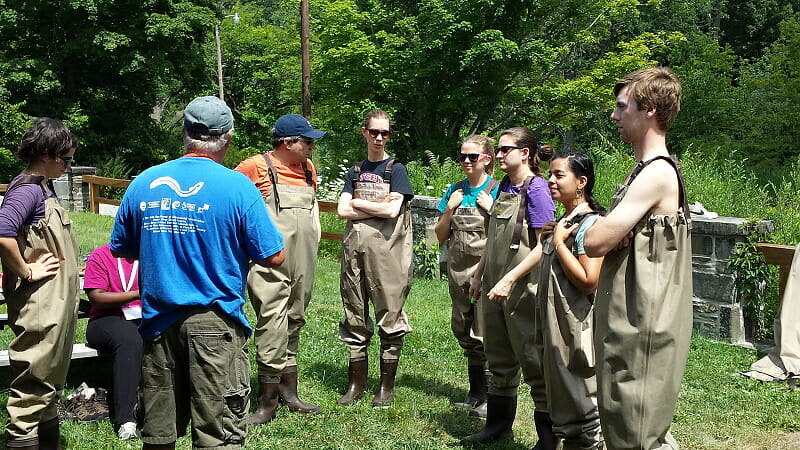
Aug 10, 2015 | Focolare Worldwide
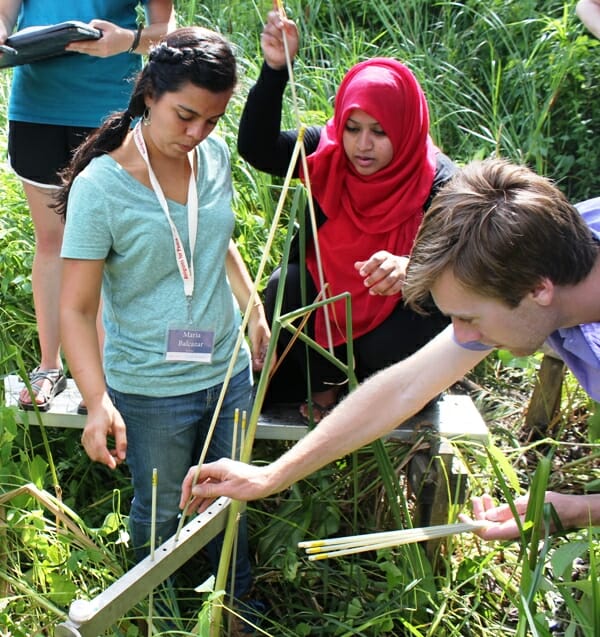 Young people from five religions and several Christian denomination, specifically chosen as emergent leaders in the environmental field, met at Mariapolis Luminosa of the Focolare in the State of New York, USA, to reflect on safeguarding the planet, our common home. Guided by the ideals of Religions for Peace (RFP) and of the Focolare the Teach-in began with an analysis of the current situation of the environment and the strong link between global stability and climate change. The phenomenon of climate change calls for a new awareness and change of view, implied by the title of the three-day event. Perhaps it will find a solution thanks to the synergy between people from different religious backgrounds. This was the wish of the organisers of Teach-in, which was held at the end of July 2015. Despite the variety of their beliefs they came to the same realisation that every effort in favor of the environment will be more efficacious inasmuch as it is done together. Amongst the interventions were those of Rev. Richard Cizik (New Evangelical Partnership) and of the Rabbi Lawrence Troster, bioethicist who said that: “By 2050 we could have 50 million climate refugees, with serious consequences for peaceful coexistence amongst peoples.” His words were echoed by Asma Mahdi, oceanographer and member of Green Muslims, highlighting that the most vulnerable countries are Muslim: “In Bangladesh, for example, if the ocean level continues to rise, by 2050, 17% of the territory will be awash, forcing 18 million people to move elsewhere.” These are alarming figures, and several Polynesian islands would completely submerged.
Young people from five religions and several Christian denomination, specifically chosen as emergent leaders in the environmental field, met at Mariapolis Luminosa of the Focolare in the State of New York, USA, to reflect on safeguarding the planet, our common home. Guided by the ideals of Religions for Peace (RFP) and of the Focolare the Teach-in began with an analysis of the current situation of the environment and the strong link between global stability and climate change. The phenomenon of climate change calls for a new awareness and change of view, implied by the title of the three-day event. Perhaps it will find a solution thanks to the synergy between people from different religious backgrounds. This was the wish of the organisers of Teach-in, which was held at the end of July 2015. Despite the variety of their beliefs they came to the same realisation that every effort in favor of the environment will be more efficacious inasmuch as it is done together. Amongst the interventions were those of Rev. Richard Cizik (New Evangelical Partnership) and of the Rabbi Lawrence Troster, bioethicist who said that: “By 2050 we could have 50 million climate refugees, with serious consequences for peaceful coexistence amongst peoples.” His words were echoed by Asma Mahdi, oceanographer and member of Green Muslims, highlighting that the most vulnerable countries are Muslim: “In Bangladesh, for example, if the ocean level continues to rise, by 2050, 17% of the territory will be awash, forcing 18 million people to move elsewhere.” These are alarming figures, and several Polynesian islands would completely submerged. 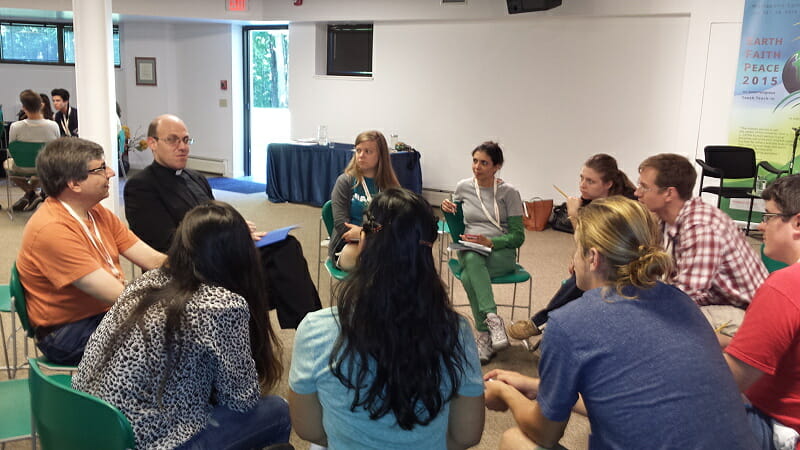 Amongst the speakers was Msgr. Joseph Grech from the Permanent Observer Mission of the Holy See to the United Nations, who referred to several excerpts from Pope Francis’s Encyclical Letter Laudato si while underscoring how economy and ecology walk hand in hand, since all our actions have an impact on nature. Three environmental researchers from three different American universities were of the same opinon: Robert Yantosca (Harvard), Valentine Nzengung (Georgia) and Tasrunji Singh (Ohio), for whom the respective religious convictions have become motivating factors and guides in the scientific effort in favour of the environment.
Amongst the speakers was Msgr. Joseph Grech from the Permanent Observer Mission of the Holy See to the United Nations, who referred to several excerpts from Pope Francis’s Encyclical Letter Laudato si while underscoring how economy and ecology walk hand in hand, since all our actions have an impact on nature. Three environmental researchers from three different American universities were of the same opinon: Robert Yantosca (Harvard), Valentine Nzengung (Georgia) and Tasrunji Singh (Ohio), for whom the respective religious convictions have become motivating factors and guides in the scientific effort in favour of the environment.  “Go out!” was the catch phrase that conducted the second part of the Teach-in and it led to the delineation of a series of behaviours to put into practice. John Mundell from the Focolare, owner of a company of environmental consultants, presented a landscape of initiatives connected to the “Earth Cube,” whose six sides present daily suggestions for renewing and conserving a healthy environment. There was also the visit to the projects at the nearby Esaurine Federal Reserve. RFP executive Aaron Stauffer, stated at the conclusion: “It has been a witness of the power of multireligious cooperation and peace.” And Brazilian, Lira Raiana, who is finishing her doctorate in ecology: “We’ve experienced that we have at least two things in common: an intense interest in sustainability of the planet and a religious belief that offers the correct motivations to take care of it. Each one of us came with our convictions and personal ideas and now we find ourselves united in the common objective of many: the protection of the earth and of its inhabitants.”
“Go out!” was the catch phrase that conducted the second part of the Teach-in and it led to the delineation of a series of behaviours to put into practice. John Mundell from the Focolare, owner of a company of environmental consultants, presented a landscape of initiatives connected to the “Earth Cube,” whose six sides present daily suggestions for renewing and conserving a healthy environment. There was also the visit to the projects at the nearby Esaurine Federal Reserve. RFP executive Aaron Stauffer, stated at the conclusion: “It has been a witness of the power of multireligious cooperation and peace.” And Brazilian, Lira Raiana, who is finishing her doctorate in ecology: “We’ve experienced that we have at least two things in common: an intense interest in sustainability of the planet and a religious belief that offers the correct motivations to take care of it. Each one of us came with our convictions and personal ideas and now we find ourselves united in the common objective of many: the protection of the earth and of its inhabitants.”
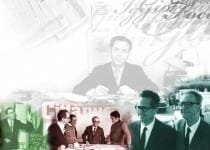
Aug 9, 2015 | Non categorizzato
 «Working in the fields, and taking care of the life of the plants, in an immense silence marked by the solar and lunar cycles, and sharing the work of creation of natural life, are also like priestly tasks, and call for concentration and sacrifice: the courage to tune in with one’s own soul, and be one with the expectation of the universe, in contact with nature which is a miraculous nursery, feeling oneself, without fainting, in the presence of God.» (FIDES, July 1938) « Man needs beauty and purity that surpasses human ideals in order to rise up to the contemplation of Mary. She was the one who lifted him up: in contemplating this, the most beautiful aspirations of the soul blossomed, and tried to capture through expressions of art, the highest ever achieved. Maternity is womanly tenderness, the most beautiful passion, the moment wherein one is able to lift oneself beyond brutality, through a surge of divinization.» (FIDES, March 1938) «The Christian revolution came about without conspiracy and did not overturn institutions, nor did it kill tyrants, but penetrated into the obsolete organisations of the old world, into the worn family, in the decrepit juridical institutes, and into social relationships intoxicated by lust. It was love that was stirring up again, to regenerate all and by which suddenly, slaves were able to transform themselves before their masters, and woman assumed a new value in the eyes of man, and heathens and labourers bridged the immense gap between them and the Greeks and Romans. ». (FIDES, February 1943 «The aware Christian – the saint – is one who uses his time carefully and is able to achieve a lot in a short time, to honour the Head of the house, for the common good and wellbeing of his brethren. This activity and ability, in the current language is called apostolate. A Christian that does not act in the manner and time assigned, is a Christian who ignores his role in the Church: he is unaware of the Church that lives because it acts and produces action. We say it produces Catholic action. In a thousand ways, all are involved. A poet can do it and likewise a half wit, a hermit and a monk, the head of a family and a department head, the city wayfarer and the cobbler in his workshop. ». (FIDES, October 1938) Source: Igino Giordani Centre
«Working in the fields, and taking care of the life of the plants, in an immense silence marked by the solar and lunar cycles, and sharing the work of creation of natural life, are also like priestly tasks, and call for concentration and sacrifice: the courage to tune in with one’s own soul, and be one with the expectation of the universe, in contact with nature which is a miraculous nursery, feeling oneself, without fainting, in the presence of God.» (FIDES, July 1938) « Man needs beauty and purity that surpasses human ideals in order to rise up to the contemplation of Mary. She was the one who lifted him up: in contemplating this, the most beautiful aspirations of the soul blossomed, and tried to capture through expressions of art, the highest ever achieved. Maternity is womanly tenderness, the most beautiful passion, the moment wherein one is able to lift oneself beyond brutality, through a surge of divinization.» (FIDES, March 1938) «The Christian revolution came about without conspiracy and did not overturn institutions, nor did it kill tyrants, but penetrated into the obsolete organisations of the old world, into the worn family, in the decrepit juridical institutes, and into social relationships intoxicated by lust. It was love that was stirring up again, to regenerate all and by which suddenly, slaves were able to transform themselves before their masters, and woman assumed a new value in the eyes of man, and heathens and labourers bridged the immense gap between them and the Greeks and Romans. ». (FIDES, February 1943 «The aware Christian – the saint – is one who uses his time carefully and is able to achieve a lot in a short time, to honour the Head of the house, for the common good and wellbeing of his brethren. This activity and ability, in the current language is called apostolate. A Christian that does not act in the manner and time assigned, is a Christian who ignores his role in the Church: he is unaware of the Church that lives because it acts and produces action. We say it produces Catholic action. In a thousand ways, all are involved. A poet can do it and likewise a half wit, a hermit and a monk, the head of a family and a department head, the city wayfarer and the cobbler in his workshop. ». (FIDES, October 1938) Source: Igino Giordani Centre

 The somewhat quirky diversity of the hall at the Chiara Lubich Centre in Trent this year was a bit surprising: 250 young people between the ages of 16 and 30 from more than 20 countries; 70 priests and seminarians and some twenty adults who are all committed in living the spirituality of the Focolare at the parish or diocesan levels. What was the idea behind this meeting which was planned for the 2cnd to the 8th of August? What is the connection between the different cultural backgrounds? The first answer can be found in the title of the meeting: “Like yesterday,” and the second answer in the city of Trent itself. All of these young people and adults were gathered to reflect on the first generative seed of their own spiritual charism and to look back even physcially at the journey that has inspired the Focolare Movement from its beginnings. “The meeting opened in an atmosphere of explosive joy,’ Ludovico and Elonora recount. “The programme is meant to be an immersion in the life of those early days and the radicalness in living the Word.” The programme alternated between thematic topics and excursions to the places where the Focolare began: Piazza Cappuccini, Fiera di Primiero, Tonadico, Goccia d’Oro. “During the Mass in the Cappuchin church,” Zbyszek writes, “we declared ourselves ready with the help of Christ’s grace, to give our lives one for the other beginning from the small things of everyday life. In the place where God had sealed the pact of unity between Chiara and Igino Giordani (Foco), we also wishe to renew that mutual love which we wish to live as they did that yesterday.”
The somewhat quirky diversity of the hall at the Chiara Lubich Centre in Trent this year was a bit surprising: 250 young people between the ages of 16 and 30 from more than 20 countries; 70 priests and seminarians and some twenty adults who are all committed in living the spirituality of the Focolare at the parish or diocesan levels. What was the idea behind this meeting which was planned for the 2cnd to the 8th of August? What is the connection between the different cultural backgrounds? The first answer can be found in the title of the meeting: “Like yesterday,” and the second answer in the city of Trent itself. All of these young people and adults were gathered to reflect on the first generative seed of their own spiritual charism and to look back even physcially at the journey that has inspired the Focolare Movement from its beginnings. “The meeting opened in an atmosphere of explosive joy,’ Ludovico and Elonora recount. “The programme is meant to be an immersion in the life of those early days and the radicalness in living the Word.” The programme alternated between thematic topics and excursions to the places where the Focolare began: Piazza Cappuccini, Fiera di Primiero, Tonadico, Goccia d’Oro. “During the Mass in the Cappuchin church,” Zbyszek writes, “we declared ourselves ready with the help of Christ’s grace, to give our lives one for the other beginning from the small things of everyday life. In the place where God had sealed the pact of unity between Chiara and Igino Giordani (Foco), we also wishe to renew that mutual love which we wish to live as they did that yesterday.”  Then we had an opportunity to be enriched by presentations from experts in the fields of communication, interreligious dialogue and cooperation and development in the Action for a United World (AMU). Thanks to them we were able to reflect on communication and the challenges of our multiethnic and multi-religious society. Much time was dedicated to delving into the topics of immigration and welcoming thanks to the precious collaboration by the Cinformi Project, which presented the model of welcoming that has been proposed and applied by the city of Trent, placing itself at our service with active workshops involving two visits to refugee camps. Some of the most unforgettable moments of the meeting were spent with a hundred refugees who are waiting to see what the future will bring.
Then we had an opportunity to be enriched by presentations from experts in the fields of communication, interreligious dialogue and cooperation and development in the Action for a United World (AMU). Thanks to them we were able to reflect on communication and the challenges of our multiethnic and multi-religious society. Much time was dedicated to delving into the topics of immigration and welcoming thanks to the precious collaboration by the Cinformi Project, which presented the model of welcoming that has been proposed and applied by the city of Trent, placing itself at our service with active workshops involving two visits to refugee camps. Some of the most unforgettable moments of the meeting were spent with a hundred refugees who are waiting to see what the future will bring.  Several of them came to see us at the meeting. Rita confided: “I was so struck by Lamin, a young Muslim from Ghana who had written a poem to his mother and wished to read it to everyone. It was a poem filled with nostalgia but also hope. The eyes of these people says it all and they can never forget.” At the conclusion of the meeting two goals were set – one short-term and the other long-term: the World Youth Day meeting (WYD) in Poland; and the unity of the world in accordance with Jesus’s prayer that all be one for which we wish to spend our lives. “We leave committed to becoming the ‘living Word,” Danilo and Emmanuele write and to take this “pure water from the source” into our own lands and into our daily life in our peripheries, offering it to every neighbour that goes by.”
Several of them came to see us at the meeting. Rita confided: “I was so struck by Lamin, a young Muslim from Ghana who had written a poem to his mother and wished to read it to everyone. It was a poem filled with nostalgia but also hope. The eyes of these people says it all and they can never forget.” At the conclusion of the meeting two goals were set – one short-term and the other long-term: the World Youth Day meeting (WYD) in Poland; and the unity of the world in accordance with Jesus’s prayer that all be one for which we wish to spend our lives. “We leave committed to becoming the ‘living Word,” Danilo and Emmanuele write and to take this “pure water from the source” into our own lands and into our daily life in our peripheries, offering it to every neighbour that goes by.”















